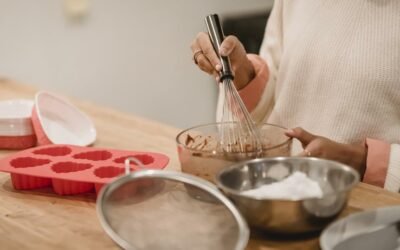Are you dealing with stubborn orange mold on your wood surfaces? Don't worry, we've got you covered.
In this article, we'll guide you through the process of getting rid of that pesky mold once and for all. With our expert tips and easy-to-follow steps, you'll be able to effectively remove the mold and prevent its return.
Say goodbye to orange mold and hello to a mold-free environment. Let's get started!
Key Takeaways
- Look for orange or orange-brown patches or spots on the wood surface.
- Note the fuzzy or powdery appearance of the mold.
- Scrub the affected area with a stiff-bristled brush or scrubbing pad.
- Apply a mold-resistant sealant to the wood surface.
Identify the Presence of Orange Mold
To identify the presence of orange mold on wood, carefully inspect the affected area for any visible signs or distinct odors. Orange mold is a type of fungus that can develop on wood surfaces, especially in damp and humid environments. It's important to detect and address the presence of orange mold as soon as possible to prevent further damage to the wood and potential health risks.
When examining the affected area, look for patches or spots that are orange or orange-brown in color. The mold may appear fuzzy or powdery and can sometimes have a slimy texture. Additionally, pay attention to any musty or unpleasant odors emanating from the wood. These distinct smells can be indicative of mold growth.
In some cases, orange mold may also cause the wood to appear discolored or stained. It's crucial to thoroughly inspect all visible surfaces, including corners, crevices, and hidden areas, as mold can easily spread and infiltrate a larger area.
If you suspect the presence of orange mold on wood, it's recommended to seek professional assistance to properly identify and safely remove the mold. Contacting a mold remediation specialist will ensure that the necessary precautions and effective treatment methods are implemented to eliminate the mold and prevent its recurrence.
Prepare the Necessary Cleaning Materials
Gather the essential cleaning supplies to effectively get rid of orange mold on wood. Having the right materials on hand will ensure that you can tackle the problem efficiently and with confidence. Here are the necessary cleaning supplies you'll need:
- Gloves: Protect your hands from direct contact with the mold and cleaning agents by wearing gloves. Latex or rubber gloves are ideal for this task.
- Face mask: Orange mold can release spores into the air when disturbed, which can be harmful if inhaled. Wear a face mask to protect your respiratory system.
- Safety goggles: Mold spores can also irritate the eyes, so wearing safety goggles is essential to shield your eyes from any potential harm.
- Scrub brush: A stiff-bristled brush will help you effectively scrub away the mold from the wood surface. Choose a brush that's appropriate for the size of the affected area.
- Cleaning solution: Prepare a solution of equal parts water and bleach or hydrogen peroxide. These solutions are effective in killing orange mold and preventing its return.
- Cloth or sponge: Use a cloth or sponge to apply the cleaning solution to the affected area and to wipe away the mold.
Remove the Mold From the Wood Surface
Once you have gathered the necessary cleaning supplies, it's time to remove the orange mold from the wood surface. Follow these steps to effectively eliminate the mold and restore the wood to its original condition:
- Begin by wearing protective gloves, goggles, and a mask to ensure your safety during the cleaning process. Mold spores can be harmful if inhaled or come into contact with the skin.
- Use a stiff-bristled brush or scrubbing pad to scrub the affected area. Start at the outer edges and work your way towards the center, applying firm pressure to remove the mold. Be sure to scrub in a circular motion to loosen any stubborn mold growth.
- After scrubbing, dampen a clean cloth or sponge with a mixture of water and mild detergent. Gently wipe the wood surface to remove any remaining mold residue. Rinse the cloth or sponge frequently to prevent spreading the mold to other areas.
Treat the Wood to Prevent Future Mold Growth
To prevent future mold growth on the wood, treat it with a mold-resistant sealant. Applying a mold-resistant sealant to the wood surface creates a protective barrier that inhibits the growth of mold and prevents it from taking hold in the future. Mold-resistant sealants are specifically designed to withstand moisture and inhibit the growth of mold, making them an effective solution for preventing mold growth on wood surfaces.
When choosing a mold-resistant sealant, opt for a product specifically formulated for wood surfaces. These sealants typically contain fungicides that actively work to inhibit the growth of mold and other fungi. Look for sealants that are labeled as mold-resistant or mold-inhibiting to ensure maximum effectiveness.
Before applying the sealant, make sure the wood surface is clean and dry. Remove any existing mold and thoroughly clean the area with a mold-killing solution. Allow the wood to dry completely before applying the sealant.
When applying the sealant, follow the manufacturer's instructions carefully. Use a brush or roller to evenly distribute the sealant onto the wood surface. Apply multiple coats if necessary, ensuring complete coverage.
Maintain a Mold-Free Environment
Take steps to ensure a mold-free environment by regularly cleaning and inspecting your wood surfaces. Mold thrives in moist and humid conditions, so it's crucial to keep your home dry and well-ventilated. Here are three essential measures to maintain a mold-free environment:
- Control humidity levels: Use dehumidifiers in areas prone to moisture, such as basements or bathrooms. Aim for humidity levels below 50% to discourage mold growth. Additionally, fix any leaks or water damage promptly to prevent moisture buildup.
- Clean and dry regularly: Regularly clean and dry wood surfaces to prevent mold spores from settling and growing. Use a mild detergent and warm water to clean the wood, ensuring you remove any dirt or organic matter that could provide a food source for mold. After cleaning, thoroughly dry the wood to eliminate any remaining moisture.
- Proper ventilation: Ensure good airflow throughout your home by opening windows, using exhaust fans, and installing vents in high-moisture areas. This allows moisture to escape and prevents it from accumulating on surfaces, including wood.
Conclusion
In conclusion, effectively getting rid of orange mold on wood requires several steps.
The first step is to identify its presence. Look for signs of orange discoloration or a fuzzy texture on the wood surface.
Once you have confirmed the presence of orange mold, prepare the necessary cleaning materials. This may include a mixture of bleach and water, a scrub brush, and protective gear such as gloves and a mask.
Next, remove the mold from the surface. Apply the cleaning solution to the affected area and scrub gently to remove the mold. Be sure to rinse the area thoroughly afterwards.
After removing the mold, it is important to treat the wood to prevent future growth. This can be done by applying a mold inhibitor or using a sealant to create a barrier on the wood surface.
Finally, to maintain a mold-free environment, it is essential to keep the area clean and dry. Regularly inspect wooden surfaces for any signs of mold and promptly address any issues.
By following these steps, you can ensure that your wooden surfaces remain clean and free from orange mold, creating a healthier and more visually appealing space.






0 Comments